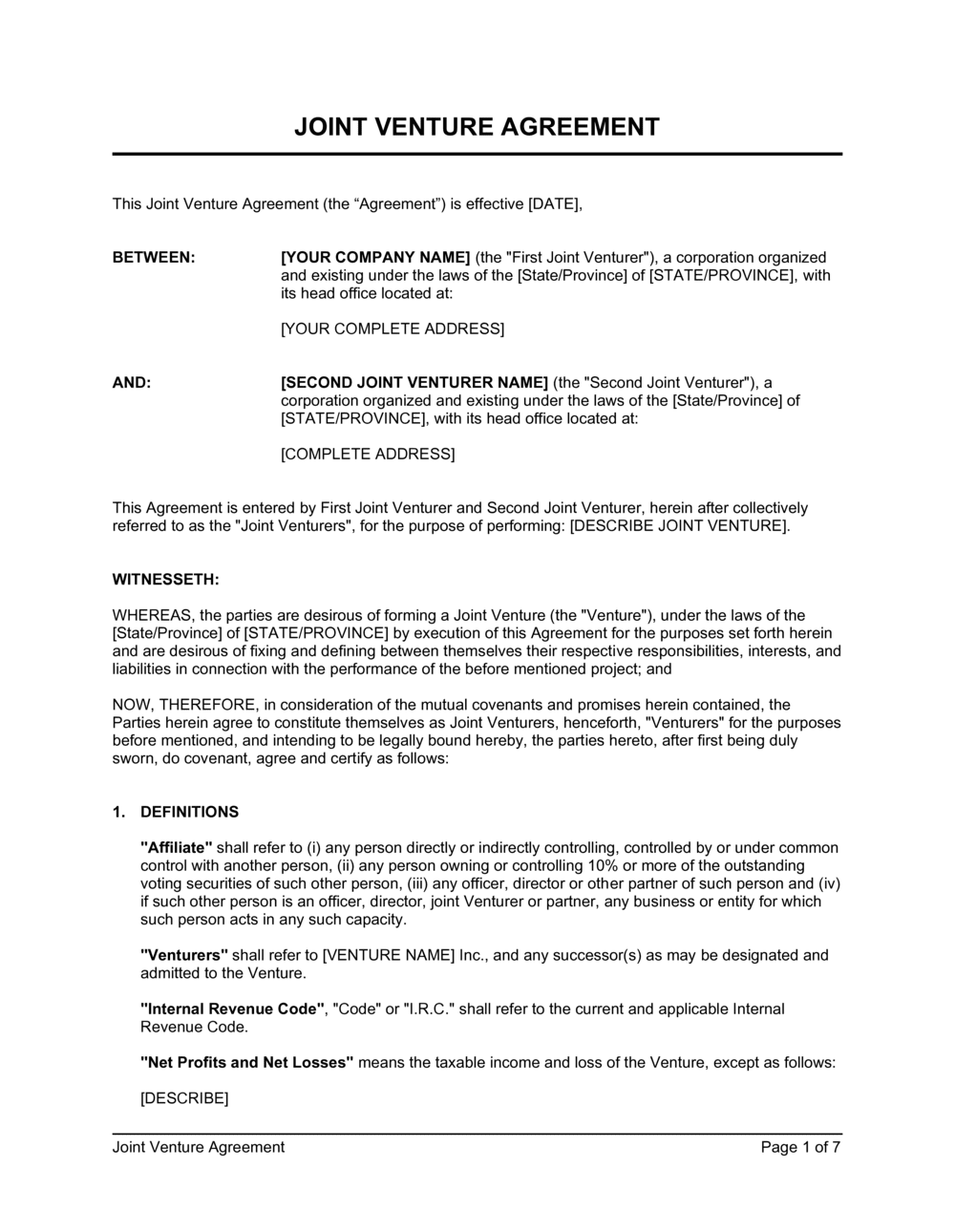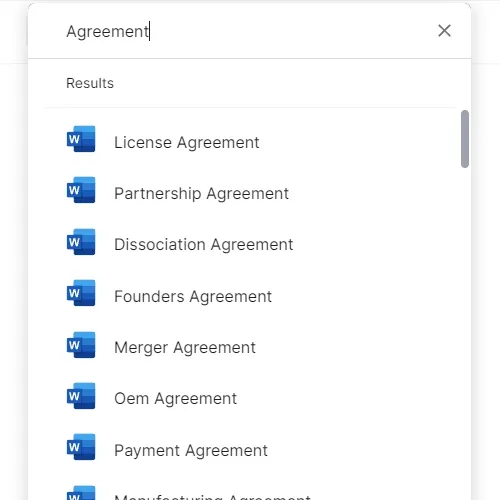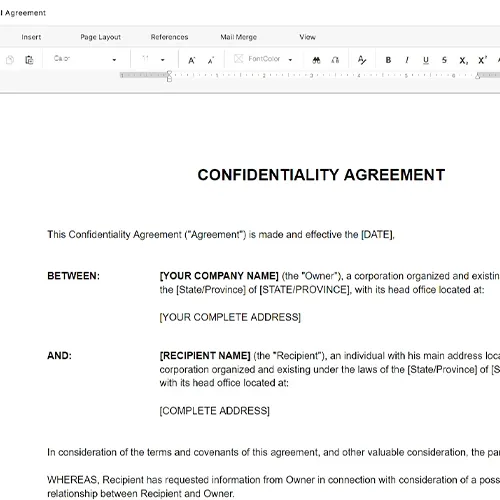Joint Venture Agreement Template

Forging Strong Alliances with a Joint Venture Agreement
In the competitive business world, strategic alliances can unlock new opportunities, enhance capabilities, and drive growth. A Joint Venture Agreement (JVA) is the cornerstone of such alliances, establishing a legal framework for the collaboration between two or more parties. This agreement sets out the terms and conditions under which the joint venture will operate, detailing each partner's roles, responsibilities, contributions, and profit-sharing mechanisms.
A Joint Venture Agreement is crucial for ensuring a clear understanding and mutual commitment between parties, mitigating risks, and fostering a cooperative environment. It provides a structured approach to managing joint activities, aligning the interests of all partners towards achieving shared strategic objectives.
What is a Joint Venture Agreement Template?
A Joint Venture Agreement template is a comprehensive guide for drafting a legally sound and detailed agreement that governs the joint venture. It ensures that all critical elements are addressed, including the scope of the venture, governance structures, capital contributions, profit distribution, and dispute resolution mechanisms. Utilizing a template streamlines the creation process, ensuring consistency and thoroughness while allowing for customization to fit the specific needs and goals of the joint venture.
Key Elements of a Joint Venture Agreement:
A robust Joint Venture Agreement should thoroughly address the following key elements:
- Identification of Parties - Clearly identifies all parties involved in the joint venture and their respective roles.
- Purpose and Scope - Defines the purpose of the joint venture, including the specific goals, objectives, and scope of activities.
- Capital Contributions - Details the initial capital contributions of each party, whether in the form of cash, assets, or services and outlines procedures for additional contributions.
- Management and Control - Outlines the governance structure, including the management roles, decision-making processes, and voting rights of each party.
- Profit and Loss Distribution - Specifies how profits and losses will be shared among the parties, typically in proportion to their respective contributions or as otherwise agreed.
- Duties and Obligations - Details the responsibilities and obligations of each party to ensure the success of the joint venture.
- Duration and Termination - Defines the duration of the joint venture and the conditions under which it can be terminated, including procedures for winding down and distributing remaining assets.
- Dispute Resolution - Includes provisions for resolving disputes, typically through mediation or arbitration, to avoid litigation and maintain a cooperative relationship.
Supporting Documents for Structuring a Joint Venture Agreement
To enhance the functionality and comprehensiveness of a Joint Venture Agreement, integrating the following supporting documents is advisable:
- Memorandum of Understanding (MOU) - Establishes the initial understanding and intent of the parties before the formal agreement is finalized.
- Business Plan - Provides a detailed plan outlining the joint venture’s strategic goals, market analysis, operational plan, and financial projections.
- Non-Disclosure Agreement (NDA) - This agreement protects sensitive information shared between the parties during and after the formation of the joint venture.
- Buy-Sell Agreement - This agreement outlines procedures for buying out a party’s interest or selling the joint venture interest, ensuring smooth transitions.
Why Employ a Detailed Template for a Joint Venture Agreement?
Utilizing a detailed template for drafting your Joint Venture Agreement offers significant benefits:
- Risk Mitigation - Reduces potential legal disputes by clearly defining roles, responsibilities, and profit-sharing agreements.
- Customizability - Allows for tailoring the agreement to accommodate the specific dynamics of the joint venture and industry context.
- Efficiency - Streamlines the agreement preparation process, saving time and resources that can be better focused on strategic initiatives.
- Strengthened Partnership - Promotes transparency and mutual understanding, laying a strong foundation for long-term collaboration.
Adopting a comprehensive Joint Venture Agreement is essential for navigating the complexities of strategic business alliances. It provides a clear, enforceable framework that aligns partners with their collective goals, ensuring that the joint venture operates smoothly and remains resilient in the face of challenges. This fundamental document facilitates operational efficacy and solidifies the commitment to shared success and strategic growth.
Updated in May 2024
Reviewed on

Forging Strong Alliances with a Joint Venture Agreement
In the competitive business world, strategic alliances can unlock new opportunities, enhance capabilities, and drive growth. A Joint Venture Agreement (JVA) is the cornerstone of such alliances, establishing a legal framework for the collaboration between two or more parties. This agreement sets out the terms and conditions under which the joint venture will operate, detailing each partner's roles, responsibilities, contributions, and profit-sharing mechanisms.
A Joint Venture Agreement is crucial for ensuring a clear understanding and mutual commitment between parties, mitigating risks, and fostering a cooperative environment. It provides a structured approach to managing joint activities, aligning the interests of all partners towards achieving shared strategic objectives.
What is a Joint Venture Agreement Template?
A Joint Venture Agreement template is a comprehensive guide for drafting a legally sound and detailed agreement that governs the joint venture. It ensures that all critical elements are addressed, including the scope of the venture, governance structures, capital contributions, profit distribution, and dispute resolution mechanisms. Utilizing a template streamlines the creation process, ensuring consistency and thoroughness while allowing for customization to fit the specific needs and goals of the joint venture.
Key Elements of a Joint Venture Agreement:
A robust Joint Venture Agreement should thoroughly address the following key elements:
- Identification of Parties - Clearly identifies all parties involved in the joint venture and their respective roles.
- Purpose and Scope - Defines the purpose of the joint venture, including the specific goals, objectives, and scope of activities.
- Capital Contributions - Details the initial capital contributions of each party, whether in the form of cash, assets, or services and outlines procedures for additional contributions.
- Management and Control - Outlines the governance structure, including the management roles, decision-making processes, and voting rights of each party.
- Profit and Loss Distribution - Specifies how profits and losses will be shared among the parties, typically in proportion to their respective contributions or as otherwise agreed.
- Duties and Obligations - Details the responsibilities and obligations of each party to ensure the success of the joint venture.
- Duration and Termination - Defines the duration of the joint venture and the conditions under which it can be terminated, including procedures for winding down and distributing remaining assets.
- Dispute Resolution - Includes provisions for resolving disputes, typically through mediation or arbitration, to avoid litigation and maintain a cooperative relationship.
Supporting Documents for Structuring a Joint Venture Agreement
To enhance the functionality and comprehensiveness of a Joint Venture Agreement, integrating the following supporting documents is advisable:
- Memorandum of Understanding (MOU) - Establishes the initial understanding and intent of the parties before the formal agreement is finalized.
- Business Plan - Provides a detailed plan outlining the joint venture’s strategic goals, market analysis, operational plan, and financial projections.
- Non-Disclosure Agreement (NDA) - This agreement protects sensitive information shared between the parties during and after the formation of the joint venture.
- Buy-Sell Agreement - This agreement outlines procedures for buying out a party’s interest or selling the joint venture interest, ensuring smooth transitions.
Why Employ a Detailed Template for a Joint Venture Agreement?
Utilizing a detailed template for drafting your Joint Venture Agreement offers significant benefits:
- Risk Mitigation - Reduces potential legal disputes by clearly defining roles, responsibilities, and profit-sharing agreements.
- Customizability - Allows for tailoring the agreement to accommodate the specific dynamics of the joint venture and industry context.
- Efficiency - Streamlines the agreement preparation process, saving time and resources that can be better focused on strategic initiatives.
- Strengthened Partnership - Promotes transparency and mutual understanding, laying a strong foundation for long-term collaboration.
Adopting a comprehensive Joint Venture Agreement is essential for navigating the complexities of strategic business alliances. It provides a clear, enforceable framework that aligns partners with their collective goals, ensuring that the joint venture operates smoothly and remains resilient in the face of challenges. This fundamental document facilitates operational efficacy and solidifies the commitment to shared success and strategic growth.
Updated in May 2024
Easily Create Any Business Document You Need in Minutes.

Download or open template
Access over 3,000+ business and legal templates for any business task, project or initiative.

Edit and fill in the blanks
Customize your ready-made business document template and save it in the cloud.

Save, Share, Export, or Sign
Share your files and folders with your team. Create a space of seamless collaboration.


